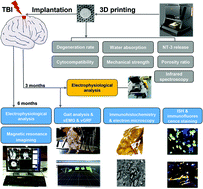3D printing collagen/heparin sulfate scaffolds boost neural network reconstruction and motor function recovery after traumatic brain injury in canine†
Abstract
Tissue engineering is considered highly promising for the repair of traumatic brain injury (TBI), and accumulating evidence has proved the efficacy of biomaterials and 3D printing. Although collagen is famous for its natural properties, some defects still restrict its potential applications in tissue repair. In this experimental study, we fabricated a kind of scaffold with collagen and heparin sulfate via 3D printing, which possesses favorable physical properties and suitable degradation rate along with satisfactory cytocompatibility. After implantation, the results of motor evoked potentials (MEPs) showed that the latency and amplitude can both be improved in hemiplegic limbs, and the structural integrity of the cerebral cortex and corticospinal tract can be enhanced significantly under magnetic resonance imaging (MRI) evaluation. Additionally, the results of in situ hybridization (ISH) and immunofluorescence staining also revealed the facilitating role of 3D printing collagen/heparin sulfate scaffolds on vascular and neural regeneration. Moreover, the individuals implanted with this kind of scaffold present better gait characteristics and preferable electromyography and myodynamia. In general, 3D printed collagen/heparin sulfate scaffolds have superb performance in both structural repair and functional improvement and may offer a new strategy for the repair of TBI.



 Please wait while we load your content...
Please wait while we load your content...